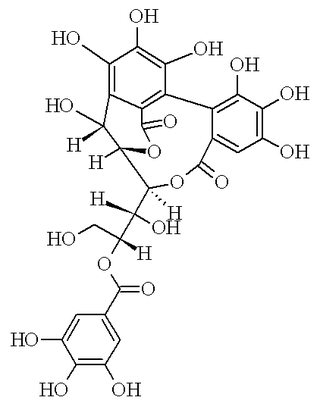 | |
| Identifiers | |
|---|---|
Except where otherwise noted, data are given for materials in their standard state (at 25 °C [77 °F], 100 kPa). |
Epicutissimin A is a flavono-ellagitannin, a type of tannin. [1]
 | |
| Identifiers | |
|---|---|
Except where otherwise noted, data are given for materials in their standard state (at 25 °C [77 °F], 100 kPa). |
Epicutissimin A is a flavono-ellagitannin, a type of tannin. [1]

Punicalagin (Pyuni-cala-jen) is an ellagitannin, a type of phenolic compound. It is found as alpha and beta isomers in pomegranates, Terminalia catappa, Terminalia myriocarpa, and in Combretum molle, the velvet bushwillow, a plant species found in South Africa. These three genera are all Myrtales and the last two are both Combretaceae.

Castalagin is an ellagitannin, a type of hydrolyzable tannin, found in oak and chestnut wood and in the stem barks of Anogeissus leiocarpus and Terminalia avicennoides.
The ellagitannins are a diverse class of hydrolyzable tannins, a type of polyphenol formed primarily from the oxidative linkage of galloyl groups in 1,2,3,4,6-pentagalloyl glucose. Ellagitannins differ from gallotannins, in that their galloyl groups are linked through C-C bonds, whereas the galloyl groups in gallotannins are linked by depside bonds.

Grandinin is an ellagitannin. It can be found in Melaleuca quinquenervia leaves and in oaks species like the North American white oak and European red oak. It shows antioxydant activity. It is an astringent compound. It is also found in wine, red or white, aged in oak barrels.

Gallagic acid is a polyphenolic chemical compound that can be found in the ellagitannins, a type of tannin, found in Punica granatum (pomegranate). It is a building block of the corresponding tannin punicalagin, punicalin, punicacortein C and 2-O-galloyl-punicalin.

Tellimagrandin II is the first of the ellagitannins formed from 1,2,3,4,6-pentagalloyl-glucose. It can be found in Geum japonicum and Syzygium aromaticum (clove).

Acutissimin A is a flavono-ellagitannin, a type of tannin formed from the linking of a flavonoid with an ellagitannin.
The Flavono-ellagitannins or complex tannins are a class of tannins formed from the complexation of an ellagitannin with a flavonoid. Flavono-ellagitannins can be found in Quercus mongolica var. grosseserrata.

Raspberry ellagitannin is an ellagitannin found in raspberries. It is a polyphenol per se, containing 6 ellagic acid-type components and two additional monomeric phenolics, for a total of 14 gallic acid units.

Punigluconin is an ellagitannin, a polyphenol compound. It is found in the bark of Punica granatum (pomegranate) and in Emblica officinalis. It is a molecule having a hexahydroxydiphenic acid group and two gallic acids attached to a gluconic acid core.

Punicacortein A is an ellagitannin, a polyphenol compound. It is found in the bark of Punica granatum (pomegranate) and in Osbeckia chinensis.

Punicacortein D is an ellagitannin, a type of phenolic compound. It is found in the bark and heartwood of Punica granatum (pomegranate). The molecule contains a gallagic acid component.

Punicacortein B is an ellagitannin, a polyphenol compound. It is found in the bark of Punica granatum (pomegranate).

The pomegranate ellagitannins, which include punicalagin isomers, are ellagitannins found in the sarcotestas, rind (peel), bark or heartwood of pomegranates.

Pedunculagin is an ellagitannin. It is formed from casuarictin via the loss of a gallate group.

Lambertianin C is an ellagitannin.

Sanguisorbic acid is a constituent of some ellagitannins. It is constituted by a hexahydroxydiphenic acid unit linked by an O-C bond to a gallic acid. The differences with its isomers, valoneic acid and nonahydroxytriphenic acid, are that the hydroxyl that links the hexahydroxydiphenoyl (HHDP) group to the galloyl group belongs to the galloyl group in valoneic acid, while in nonahydroxytriphenic acid, the hexahydroxydiphenic acid unit is linked by a C-C bond to gallic acid.

Nupharin A is an ellagitannin found in Nuphar japonica. It is a molecule with three gallic acid units and one hexahydroxydiphenic acid unit attached to a glucose residue. It is an isomer of punicafolin and tellimagrandin II.

Urolithins are microflora metabolites of dietary ellagic acid derivatives, such as ellagitannins. They are produced in the gut, and found in the urine in the form of urolithin B glucuronide after absorption of ellagitannins-containing foods, such as pomegranate. During intestinal metabolism by bacteria, ellagitannins and punicalagins are converted to urolithins, which have unknown biological activity in vivo.

Nonahydroxytriphenic acid is a moiety found in some ellagitannins such as roburin A, B,C and D, castalagin or grandinin.